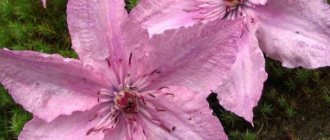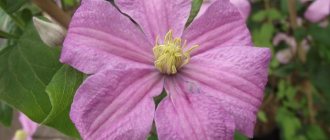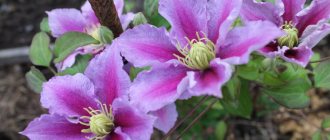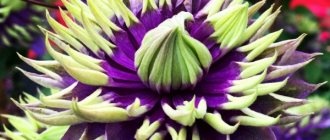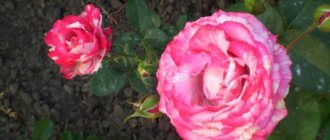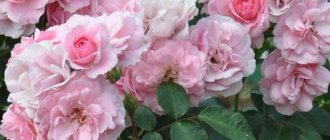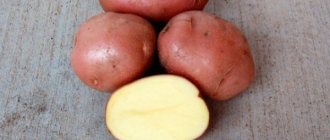Plants » Flowers
0
166
Article rating
Kira Stoletova
The royal clematis Andromeda flower is part of the Patens group - plants that are distinguished by their large stems, inflorescences and bright colors. Let's consider the main description of the variety, the rules for its planting, care and methods of propagation.
Clematis andromeda
Description of the plant
Botanical name: clematis andromeda.
A two-colored, early-flowering plant reaches 4 m in height when mature. The shoots are massive, tough, curly.
The flowers are large, 15 cm in size, and consist of elongated petals, pointed at the tips. The color of the sepals is two-colored - the main tone is snow-white, in the center there is a wide purple or burgundy stripe, the core is a rich yellow hue.
The leaves are green, oval, sharp and smooth towards the tip. The root system is well branched and superficial.
Flowering occurs in two stages - in spring and summer it forms semi-double flowers, in autumn solitary. During the budding phase, the shoots growing upward are densely covered with bright inflorescences, which fall in a cascade, creating a bright and colorful blanket.
Description of the variety
Clematis "Andromeda" is a tall climbing shrub - liana, which is characterized by abundance of flowering. This large-flowered variety begins to bloom early. It is most often used for vertical gardening, since in a short period of time clematis can entwine support structures and walls of dwellings.
The liana is characterized by abundant flowering. Proper care, proper watering, fertilizing, pruning contribute to the growth of the bush to a height of 400 centimeters. Andromeda's flowers are large, their diameter can reach 16 centimeters. The buds are very beautiful, they are snow-white sepals with bright pink stripes in the center. The stamens of the flower are large and golden.
The ideal place for a vine to grow in a garden is in the shade, where it will bloom for a long time. When warm days arrive, single flowers appear on the shoots. After the plant overwinters, it will delight with a large number of large buds. The flowering period is considered to be the middle and end of May, and the end of this phase occurs in the last days of June.
The advantages of this type of clematis include the following features:
- rapid branching of vines;
- early period of bud opening;
- attractive appearance;
The disadvantages of this plant include the changeable shape of the flowers, dependence on the temperature characteristics of the environment, and the appearance of a small number of buds in the first year after planting.
Landing Features
Seedlings are planted in the spring, when the last frosts have passed and the soil has warmed to 10-12°C.
Andromeda clematis
In regions with warm climates, they are planted in early autumn - in the first half of September. This gives the bushes time to take root and prepare for the upcoming winter.
Preparing the site
This plant loves a lot of light. It can also grow in slight shade, the main thing is that it is illuminated by sunlight in the morning and evening hours.
Choose a windless area without stagnant moisture, otherwise the clematis will quickly dry out or rot. You should not plant under the walls of a house or outbuilding, where rainwater flowing from the roofs will cause rotting and death of the crown.
Grows well on light, loose soil with a high content of organic and mineral components. When planting on sandy loam, you will need to add a couple of buckets of clay; on loam, add sand or vermiculite - 20 kg per 1 m².
Acidity levels should be within 6-7 units. If it exceeds the norm, sprinkle the planting area with 350 g of dolomite flour, slaked lime or calcite per 1 m².
After adding the necessary components, deep digging, leveling and watering are carried out.
Preparation of planting material
You can purchase seedlings at one of the specialized nurseries. They are usually sold in containers so that the roots are protected from drying out.
Choose mature bushes that have several stems and are densely covered with foliage. Such plants already have a well-developed root system, which means they will successfully take root after transplanting into open ground.
Pay attention to the crown - shoots, leaves and buds of healthy seedlings do not contain mechanical injuries or signs of damage by diseases and parasites.
Before planting, clematis is saturated with moisture - soaked in water for three hours, the roots are lightly trimmed (by 2-3 cm) to stimulate further growth of new shoots.
Landing technique
Two weeks before planting, dig holes twice the size of the roots. Approximate dimensions are 40x50x60 cm. First, drainage is laid to improve the outflow of excess moisture. Use pebbles, crushed stone or brick chips.
Clematis andromeda photo and description
Sprinkle the top with a nutritious soil mixture made from a mixture of humus, dug soil and compost, mixed in equal quantities. To increase fertility, 30 g of wood ash, 100 g of superphosphate and 300 g of dolomite flour are added to this composition.
The roots of the plant are lowered, straightened, and filled with the remaining soil to the top so that the root collar is 12 cm underground. Compact, moisten, mulch with peat or last year's manure.
When growing in groups, it is necessary to maintain a distance of at least 70 cm.
Description of clematis Andromeda
Clematis variety Andromeda forms powerful, well-leafed plants. With proper care, vines can reach a height of 4 meters. Young stems are quite fragile and vulnerable to strong gusts of wind. Two-year-old shoots have time to become woody and acquire a brownish-red tint to the bark. The root system of clematis Andromeda is well developed, not only at the surface of the earth, but also at depth, which allows the vine to extract moisture from the deep layers of the soil.
Descriptions and reviews of clematis Andromeda are often contradictory, which is confirmed by photos of gardeners taken in different climatic conditions. And if in the southern regions, where there is enough warmth and sunlight, the variety shows excellent results, giving two waves of flowering during the summer season, then in the northern latitudes this requires some effort.
The Andromeda clematis variety is considered cold-resistant, but is not frost-resistant. It requires careful shelter for the winter. Shoots caught by frost will either not bloom or will give one wave of flowering, and most likely with non-double flowers.
At the same time, clematis Andromeda does not like direct sunlight, but also does not tolerate shade. It is best to plant it on the western or eastern side of buildings or small architectural forms. In this case, the plant will be in light partial shade for part of the day.
Watering should be moderate. You should not plant clematis Andromeda in lowlands or on slopes. In the first case, it may die from waterlogging during rapid melting of snow or heavy rains. In the second, the soil at the roots will overheat and dry out, which will also not benefit the vine. There are quite a few nuances in growing Andromeda clematis, but they all pale in comparison to the beauty of the flower.
Which pruning group does it belong to?
According to breeders, clematis Andromeda belongs to the second group of pruning. This means that with proper care and favorable conditions it will produce two waves of flowering per season. To do this, after the end of flowering of last year's shoots, they are shortened by about a third, which causes the active formation of new shoots. They will delight you with flowers in the second half of summer.
Care
Watering
In the first month of development, the seedlings are watered every day - a bucket of water is poured under the bush. Moisture will help them take root and grow faster.
In the future, moisturize frequently and abundantly:
- In spring and summer, when there is no precipitation, every three days.
- In autumn, the need for moisture is determined by the condition of the soil - if it has dried to a depth of 5-6 cm, it’s time to moisten it.
The culture responds positively to periodic sprinkling of the crown in the evening. This procedure increases decorativeness, stimulates the growth of new stems and leaves and prevents the appearance of parasites.
Mulching and loosening
After each watering, the soil is loosened so that it retains its moisture and breathability qualities. They also periodically weed between the rows and pull out weeds, which are an excellent breeding ground for pests and diseases.
Clematis andromeda pruning group
At the very end, mulch from peat or humus is added - it protects the roots from drying out and prevents the growth of unnecessary vegetation.
Feeding
Clematis requires balanced and regular nutrition for full growth and long flowering.
The first time feeding is applied in the third year of development. Scheme (quantity is calculated for 10 liters of water):
- in early spring, before the vegetative buds swell, water with urea - 10 g;
- at the beginning of summer, a solution of 50 g of ammonium nitrate is poured under each bush;
- then, before the onset of autumn, they are fed with liquid mullein (1:10) or the ready-made store-bought preparation Kemira Plus at intervals of two weeks;
- when the vine fades, feed it with superphosphate and potassium - 15 g;
- in the fall, after leaf fall, spill a solution of wood ash - 1 kg (consumption per bush - 0.5 l).
It is advisable to combine root nutrition with watering. This will improve the quality of absorption of nutrients and prevent them from burning.
Trimming
This procedure is carried out every canopy - all branches are cut to a height of about 1.5 m, leaving 10 to 15 nodes. In winter, no more than 10 strong branches should go, weak and thin ones are cut out onto a stump. With this selection, flowering next year will be lush and abundant.
Also in the spring, sanitary pruning is necessary - remove frozen, shriveled, broken stems and damaged by diseases and parasites.
In the summer, when the plant is actively growing new growth, you can cut off shoots that are growing in the wrong direction or thickening the crown into rings.
All manipulations are carried out using a sharp and sterile pruner. The cut sites are irrigated with copper sulfate, which helps to avoid infection.
Preparing for winter
Almost all varieties of clematis are considered frost-resistant, but at an early age they need insulation. All work is carried out before the onset of severe frosts (-4-6°C).
After autumn pruning, when weak and non-viable parts are removed, the tree trunk area is mulched with peat or humus (15 cm in height).
The branches are carefully tied, bent to the ground, and secured with staples. The top of the bush is covered with hay, straw or fallen leaves. To prevent the shelter from being blown away by the wind, slate or spruce branches are laid on top.
With the arrival of spring, when the snow thaws and the last frosts pass, the insulating material is removed, the branches are untied and straightened.
Clematis Andromedas planting and care
Clematis Andromeda: photo of the variety
This large-flowered plant of this variety is quite unpretentious, although in some respects it is quite demanding. It is recommended to plant Clematis Andromeda immediately in a permanent place of growth, since it has an extremely negative attitude towards transplants. If this cannot be avoided, and the replanting procedure is absolutely necessary, then for several years after this the shrub will have rather weak flowering, and its growth will be much slower. This happens because during this period the plant devoted all its energy to adapting and rooting its roots; all nutritional elements will be directed toward such rooting. It should be immediately noted that this variety of clematis is planted in open space no earlier than the last days of May, since the soil has not yet warmed up to the required extent until this time.
Before planting this variety of clematis, you should wisely choose a place for its growth. The following tips will help you with this:
- — The growth of this shrub is extremely negatively affected by gusty and draft winds, so the planting site should be chosen sufficiently protected from drafts, with easy ventilation.
- — To get good development, the shrub needs a fairly strong and stable support. That is why this plant is most often planted near the walls of buildings or various fences. Moreover, the distance between the clematis and the supporting object should be at least half a meter. If a plant is planted near a metal fence, this distance is increased so that when heated in the sun, the metal frame cannot burn the foliage and shoots of the bush.
- — An excess of sunlight can also negatively affect this clematis, so it would be best to choose a place with a little shade. Otherwise, the flowers of this plant will fade quite quickly.
- — An excellent option for the growth of this plant would be to find it in moderately moist soil, with a high content of humus. Sandy or loamy soil is ideal.
- — It is strictly forbidden to plant this shrub in a lowland, or in a place near which there is groundwater, since such excess and stagnation of liquid can have a detrimental effect on the roots of clematis. For prevention, when planting clematis, a drainage soy is placed at the bottom of the dug hole in order to avoid moisture stagnation.
To prepare a site for planting this clematis, you should dig the soil well and add fertilizer to it, most often humus. But you should know a very important fact that fertilizing with manure is strictly prohibited for this plant, otherwise such fertilizer will lead to quite severe burns of the clematis root system.
Seedlings of this plant for planting should be purchased at two years old, as they take root best. But before purchasing a young plant, inspect it carefully. The seedling must have fairly developed roots; this is when a young plant has at least three long roots of 10 centimeters each, then we can consider that the seedling is quite strong and healthy. Before planting a seedling in the ground, it must first be prepared. To do this, it is soaked for about 3 hours in cold water.
When planting a seedling of this variety, a number of features should be observed, such as:
- — In a pre-selected and prepared area, dig a hole with an approximate depth of 75 centimeters and a width of 50 centimeters. The best distance between holes will be 65 centimeters.
- — A layer of drainage, approximately 20 centimeters thick, is placed at the bottom of the hole. In the form of drainage, you can use clay shards, broken bricks, expanded clay, pebbles, or gravel.
- — A fertile soil mixture is poured on top of the drainage layer, consisting of: the top layer of garden soil, which was obtained from this hole, as well as compost and humus in equal parts. All this is mixed and diluted with 300 grams of dolomite flour, 100 grams of superphosphate, as well as two tablespoons of regular ash.
- - The resulting soil mixture is poured into the dug hole, and it is filled halfway, forming a small mound. A prepared seedling is placed on this mound and its roots are carefully straightened along the slopes.
- — Next, the hole is completely filled with the remains of the prepared soil mixture, not forgetting to deepen the root collar of the plant by about 12 centimeters.
- — After planting a young plant, it should be watered abundantly.
As experienced gardeners advise, in order to retain the necessary moisture in the soil, the tree trunk of a young shrub should be mulched. Ordinary ash is perfect as mulch.
This variety of clematis does not like an excess of liquid in the soil, so the watering procedure for this plant is carried out in moderation and volume. In normal weather, one watering procedure per week will be sufficient. But in dry and very hot weather, the number of waterings is increased to three times a week. During prolonged rains, you should not water the plant. It should be noted that approximately 30 liters of water should be consumed per shrub at a time, and 20 liters is sufficient for young seedlings. The best time of day for watering is considered to be late evening, thanks to which the chance of the plant getting burned is reduced to a minimum.
To get good and full development, this variety of clematis requires regular fertilizing procedures, both organic and mineral fertilizers. The procedure for feeding the trunk circle of the bush is carried out at least four times in one season, and these actions are performed only after rain or good watering.
Fertilizing can be done according to the following scheme:
- — For the first three years of a plant’s life, it is given fertilizer consisting of a solution of dolomite flour in the following ratio: approximately 200 grams of the substance per 10 liters of water. Moreover, the water must be settled and warm.
- — In the spring, fertilizing is made from a urea solution; for this you need to dissolve 1 teaspoon of urea in 10 liters of water.
- — In the summer, the bushes are fed with mineral fertilizers or a solution of mullein, which is diluted in a ratio of 1 to 10. At the very beginning of June, ammonium nitrate is added to the soil, and 50 grams of it are dissolved in 10 liters of liquid and there should be no more than one per bush buckets. The best option for fertilizing would be at intervals of 1.5 weeks. It is also important to alternate types of fertilizing.
- — After the end of the flowering period, it is customary to feed this subspecies of clematis with fertilizers based on potassium or phosphorus.
- — In the autumn, it will be good to add wood ash to the soil, and in liquid form. A solution is made and about half a liter is used per plant.
It is important to know and remember that during the flowering period of this shrub, all fertilizing procedures are stopped.
The Andromeda clematis variety is very sensitive to soil overheating, which is why it requires mandatory mulching of its tree trunk circle. It is best to mulch with a layer of 15 centimeters. Plus, you can slightly shade the bottom of the bush with small garden crops, for example, daylilies and astilbes. Moreover, they will not only serve as some protection from the sun for the root system of the shrub, but will also be able to remove excess liquid from the soil. This way you can avoid stagnation of moisture in the soil. The loosening procedure is most often done in months such as June and September. It is produced so that oxygen can freely pass to the roots of the bush.
The procedure for pruning clematis Andromeda is performed for this plant in the autumn. To do this, a cut is made at a height of about one and a half meters (12-15 knots need to remain). Although only a maximum of 10 of the healthiest and strongest shoots remain for the winter period, which are covered for insulation with covering material, from winter frosts. All this should be done before the cold weather arrives, and the weather should be dry, the temperature can be minus 5-7 degrees. First of all, damaged and dried parts are removed from the shoots. Next, the shoots are removed from their support and laid out on pre-arranged boards located nearby. The top of the plant is sprinkled with dried leaves, hay or straw and a frame is built. The covering material is stretched on the supports in such a way that the bush is protected from precipitation and at the same time so that it can breathe. With the arrival of spring warming, when the night frosts pass, the clematis shelter is gradually removed. Otherwise, the bush may suffer from damping off.
Reproduction methods
Gardeners use several methods for propagating this crop; if you follow the rules for preparing the material, planting and caring, your efforts will be justified.
Clematis andromeda reviews
Cuttings
Cuttings are taken in spring or summer during pruning. The apical parts with several internodes, leaves and buds are used. The optimal length of shoots is 12-15 cm.
All leaves are removed from below, then dipped in one of the growth stimulants for an hour. This will help the branches take root faster. Plant in a loose and light mixture of humus, sand and peat, mixed in equal quantities. The depth of planting cuttings is 3-4 cm.
The plantings are moistened, covered with transparent material, and placed in a warm place with diffused daylight.
Ventilate every day to prevent mold from forming, and water as the substrate dries. In about 2-3 weeks they will take root. This can be determined by the new leaves. Then the shelter is removed and grown for another month so that the seedlings grow roots. Then they are planted in open ground in the same way as purchased plants.
Stem layering
On an adult vine, choose the most flexible woody shoot that is close to the ground. Remove all the leaves on it. They are lowered in a horizontal position into a dug groove to a depth of 5-6 cm. They are covered with the nutrient composition as when planting cuttings.
On the eve of autumn frosts, sprinkle with fallen leaves, sawdust or compost.
In the spring, when the snow melts and the above-zero temperature stabilizes, the branch is removed from the ground and cut off from the mother bush. Divide into parts so that each has roots. Planted individually in a permanent habitat in the garden or flower garden.
Dividing the bush
Typically, this propagation method is used for old vines that have stopped growing, bloom poorly and need rejuvenation.
The breeding technique is as follows:
- clematis is watered abundantly and removed from the soil after an hour;
- wash off the remaining soil and dry it;
- divide the root system into parts with a garden shovel, so that each remains with one stem and several roots;
- The cut sites are sprayed with a solution of copper sulfate, dried, and planted in the garden or flower bed.
Further care for seedlings is the same as for adult plants.
Reproduction
The Andromeda variety is propagated in different ways:
- seeds;
- pinning;
- dividing the bush;
- layering.
The most effective methods of reproduction include the formation of layering. Using this method, the Andromeda variety is propagated as follows:
- A healthy bush about 5 years old is dug out completely, trying not to damage the root system of the plant.
- Without destroying the earthen lump as a whole, excess soil is carefully shaken off the roots.
- After this, the bush is divided so that each part contains at least one bud on the root collar and has a developed root system.
- On the same day, all the resulting divisions must be planted in new places as quickly as possible, so planting holes are prepared in advance.
- After transplanting, the plants are watered moderately.
Despite the stress that transplantation inevitably causes, cuttings of the Andromeda variety quickly take root in a new place.
Diseases and pests
Clematis Andromeda rarely becomes infected with infections and pests; only weakened shrubs that grow without proper care and attention are prone to this.
Clematis andromeda
Alternaria blight
This disease appears in late summer or early autumn. Signs: necrosis of leaves and stems. Usually the infection damages the old parts, but with strong mass spread it spreads to young shoots and foliage. If left untreated, the plant will dry out in a short time.
To combat this disease, copper-containing preparations are used - Bordeaux mixture or copper sulfate.
Gray rot
Appears in damp and rainy weather, especially if the bushes are planted too densely.
Leaves and shoots become covered with brown spots that grow quickly. A grayish fluffy coating forms on top.
All damaged areas are cut off. The crown is irrigated with Fundazol or Azocene solution.
Powdery mildew
This fungal disease can be identified by a whitish coating on the surface of all organs. As a result, the plant stops growing, blooms sparingly and gradually withers.
First, the infected tissue is removed, then the crown is treated with a copper-soap solution - mix 250 g of laundry soap with 25 g of copper sulfate and 10 liters of water.
Rust
Light brown or red growths on the surface of stems and leaves are a sure sign of this infection. Over time, the infected areas turn brown and dry out.
Clematis andromeda description
Treatment is carried out in two stages - the diseased parts are cut off, then the crown is irrigated with fungicides - Bordeaux mixture or copper sulfate.
Wither (Wilt)
The fungus parasitizes the shoots, leading to the loss of their turgor. The stems quickly wither, dry out and in a short time the plant dies.
The bush is treated with a 0.2% concentration of Fundazol solution.
Septoria
With this disease, gray spots with a red border appear on the leaves of clematis. The affected tissues quickly die and the plant dies.
To destroy the infection, preparations containing copper are used - Bordeaux mixture or copper sulfate.
Aphid
This parasite lives in colonies on the underside of clematis leaves. It multiplies quickly and can lead to the death of a bush in a short time.
It feeds on the juice of leaves, buds and young growth. The affected parts curl, dry out and fall off.
In the fight against insects, Karbofos, Fitoverm or Aktaru are used.
Spider mite
This pest appears in extreme heat and drought. It entwines the underside of leaves and internodes with a fine web. Loves to enjoy the juice of leaves and buds. The damaged parts become covered with a marble pattern, wrinkle and dry out.
Acaricides - Actellik or Aktara - will help destroy the tick.
Nematode
Young foliage and buds are affected, as a result of which they acquire a brown tint and dry out.
You can get rid of this pest using insecticides - Karbofos, Fitoverm or Karate.
To support the immune system and protect against infections and parasites, you must follow several preventive rules:
- buy only healthy planting material;
- maintain cleanliness in the flower garden - remove weeds and plant debris in a timely manner, weed and loosen the soil;
- promptly cut out non-viable parts of the crown;
- systematically water and feed the vine;
- avoid dense plantings.
Landing rules
Clematis is a light-loving plant, so it is best to plant it in a sunny place. “Andromeda” can even be planted in the open sun, for example, it can be the canopy of a home porch. The mistake of many gardeners is to plant this vine using a metal support or along a metal fence. In this case, in extreme heat, the metal heats up and burns the plant. For this reason, the distance from such structures should be at least 100 centimeters.
In the southern region, clematis can be planted in partial shade. Since this type of plant does not tolerate wind, they should not be placed in an area that is well-ventilated. This representative of the flora is adversely affected by fogs and sudden temperature changes; these facts also need to be taken into account when choosing a location. The liana needs a fertile substrate, which is characterized by nutritional value and looseness. The best option for clematis is considered to be loamy, sandy loam soil with a neutral, slightly acidic or alkaline reaction.
Since “Andromeda” is characterized by rapid development, it is worth adding humus, compost, and nitrogen to the soil. When planting this plant, you should maintain a distance between representatives of at least 100 centimeters.
Thus, adult vines will not interfere with each other’s growth and development.
To plant a seedling, you need to dig a hole 0.5 meters deep and wide. The bottom of the hole is covered with compost or ash. When planting a bush, it is worth deepening its neck a couple of centimeters. If there is groundwater in the area of future clematis growth, a drainage layer must be made at the bottom of the hole. If the hole is equipped with sand, this will help eliminate excess moisture. You can use small pebbles and broken bricks as drainage.
When planting a seedling, do not forget about installing a support; for this purpose, you can use a pole, dry wood or slats. The time for the procedure depends on the climatic conditions of the area. The best period for planting a bush is spring and the complete absence of frost. You can plant vines in the autumn and even throughout the year.
In winter, planting material must have a closed root system.
When planting Andromeda, you should give preference to strong and healthy seedlings . If the planting material is small, then it should be grown in greenhouse conditions. In autumn, the plant should have vegetative buds, and in spring - several shoots. Clematis that is ready for planting should have 3 or 4 elastic roots, the length of which is at least 10 centimeters.
All clematis love abundant watering, and Andromeda is no exception. However, this event should not be frequent. It is worth irrigating the bush once every 7 days, subject to normal weather conditions. During hot weather, the number of waterings should be increased by 3 times. One event will require 20 liters of water for one young representative. An adult clematis needs 10 liters more.
In summer, irrigating the plant should be done in the evening, namely at sunset. Profusely flowering representatives do not need to be fertilized frequently. It is best to use organic matter or a mineral mixture for this purpose. Fertilizing should be done after rains or heavy irrigation.
The liana needs to be fertilized throughout the season.
- In the spring. To quickly grow green mass, clematis can be fertilized with diluted urea. To do this, 2 teaspoons of the substance are diluted in 20 liters of water.
- In summer. Before the flowering phase begins, you need to feed the plant once or twice a week. In this case, it is worth following the rule of alternating different substances that are not too concentrated. You can fertilize the bush with mullein, a liter of which is diluted in 10 liters of water. Alternatively, you can use ammonium nitrate. When the buds bloom, you need to stop feeding the vine.
- In autumn . During this period of the year, “Andromeda” can be fed with an aqueous solution of ash. One representative of the flora requires no more than 500 milliliters of the substance.
Mulching and loosening the tree trunk circle has a beneficial effect on the plant. You need to prune the plant in two steps after flowering, removing all faded parts.
During the winter cold, clematis need to be covered, using material that does not allow moisture to pass through. The bush must be covered with a light substrate, and then covered with spruce branches. In this case, the use of sawdust is not recommended.
Application in garden design
In the modern landscape, bright and attractive clematis is of great value:
Clematis andromeda photo
- it is planted singly near arches, gazebos, terraces, fences;
- combined with other varieties with white, purple and blue inflorescences, this produces a very beautiful multi-colored hedge;
- Often the vine is framed with low-growing plants - hosta, marigolds, calendula, etc.
Reviews
This perennial vine is in good standing among gardeners and has received many positive reviews:
- many value clematis Andromeda for its good frost resistance, so they are grown in different regions of the country;
- others like that it grows quickly and blooms luxuriantly, creating a bright and thick blanket of numerous inflorescences;
- The great advantage of the variety is the ability to successfully reproduce in different parts, which makes it possible to grow your own bushes on the site.
Reviews from gardeners
Natalya, 46 years old, Krasnoturinsk
I bought “Andromeda”, the picture simply enchanted me. For three years I suffered with winter shelters, but I did not see normal flowering on last year’s shoots. Finally, I made up my mind and radically trimmed the entire bush in the fall. In the spring, I raked away the mulch, and the bush began to grow vigorously. The flowering was simply magnificent: it began in July (early for us), and before the frost the bush was strewn with large, non-double flowers. I concluded: the variety winters well when pruned according to the third group. At the same time, the plant is stronger and the flowering is much better.
Svetlana, 53 years old, Moscow region
This variety is my favorite. Unpretentious and very decorative. The bush is quite old and weaves around my gazebo. There are many flowers every year, but double flowers are rare. In the fall, I cut them in the 2nd group, lay them on slate, with spruce spruce branches and spunbond on top. In winter, I try to put a large snowdrift on it, and in the spring, remove the cover early. There was never any freezing or dampening of the buds.
Dmitry, 61 years old, Rostov
The variety is one of the most spectacular, especially in the first wave of flowering, when it is abundantly covered with large double flowers. Here it grows in partial shade near the gazebo and during the season it encircles it almost completely.
